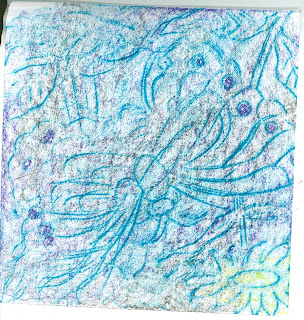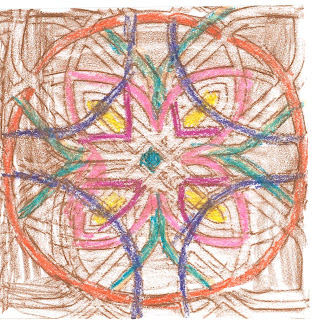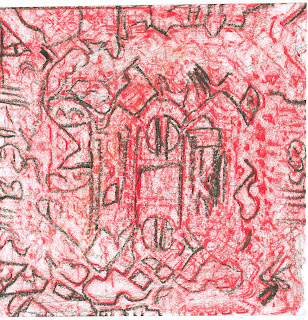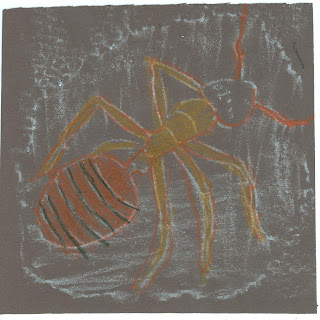Name Liza Camhi
Strategy: Multiple Intelligences or Triarchic Model
TIERED Instructional Project #1
Grade Level & Content: 5 Art
Title: Frida’s Story Through her Art
Power Standard(s) It is expected student will:(5) 2.3 discuss artistic styles, e.g, define characteristics in works of art that identify individual artists, groups of artists, or cultures (NS 4.5.2)(5) 2.6 engage in art historical research/inquiry, e.g., find answers to questions about an art object’s time, place or people by examining images, reading, listening, etc. (NS 4.5.2)
Objective(s)-Student will relate the symbolism (hair cut off, Mexican motifs, heart surgery, and pets) found in Frida Kahlo’s artwork to the artist’s life.-Student will listen to and discuss the main events of Getting to Know the World’s Greatest Artist’s: Frida Kahlo by Mike Venezia.-Student will identify the events of the artist’s life as they are revealed in Frida Kahlo’s self-portraits through a group project.
Kid-friendly Objective(s) or Essential Question(s)1. How does an artist paint his /her autobiography?2. How would I paint my autobiography?3. What are the important events in my life that I would want to show in my self-portrait?4. How can I figure out what the artist is trying to say in his/her artwork?
Pre-Assessment KWHL table: What do I already know?, What do I think I know?, What did I learn?, What do I want to learn?
Final Assessment: Group: The Task Activities will be graded by rubric. Individually: A fill in the blank test on the life and art of Frida Kahlo. (20 questions)
Whole Class Activities- (visual/spatial, verbal/linguistic, interpersonal, intrapersonal)
Day 1: The teacher will display Frida Kahlo’s Self-Portrait with a Monkey for the class. The class will discuss what they know previously about the artist and this artwork from the project they did in second grade. The student will fill in his/her KWHL chart (What do I already know?) (What do I think I know?) and share his answers with the group. The student will listen to a reading of Getting to Know the World’s Greatest Artists: Frida Kahlo by Mike Venezia pgs. 3-19. The student will fill in his “What have I learned?” section based on the day’ reading and share his answers with the class.
Day 2: The class will review discuss the previous weeks reading. The student will listen to Getting to Know the World’s Greatest Artists: Frida Kahlo by Mike Venezia pgs. 20-32. The student will finish filling in his “What have I learned?” section of his KWLH chart and share his answers with the class. The student will write at least two items in the section “What do I want to learn?” in his KWHL chart. The student will listen to an explanation of the 5 task activities he can choose from. He will fill in a choice questionnaire and list his favorite task activities from 1-5. Day 3: The student will be assigned to his task group. The teacher will give specific jobs to each member of the group.
Task 1 Activities (Group) Group will create an illustrated timeline of the artist’s life. The timeline must include important events in the artist’s life and explain how they influenced specific works of art created by Frida Kahlo. There must be a minimum of 7 illustrations of to go along with the timeline. (logical/mathematical, verbal/linguistic, interpersonal, visual/spatial)
Task 2 Activities (Group) Group will create an original Frida Kahlo self-portrait poster that describes an important event in the artist’s life. The poster must represent the style in which Frida Kahlo created her art.
(interpersonal, visual/spatial)
Task 3 Activities (Group) Group will write and perform a five- seven minute skit based on a period of the artists life. The skit must include three major events that influenced the artist’s work.
(bodily/kinesthetic, verbal/linguistic, interpersonal)
Task 4 Activities (Group) Group will work individually on a journal entry in the voice of Frida Kahlo. The student must write 3 paragraphs describing an event in Frida Kahlo’s life as if it happened that day. The student must describe how they would feel if they Frida Kahlo on that particular day. (verbal/linguistic, interpersonal, intrapersonal)
Whole Group Sharing: Task 1 Group will share their timeline with the class, read the events, and explain their illustrations. Task 2 Group will show their poster to the class describing how they were influenced by the artist’s life and style in their poster. Task 3 group will perform their skit for the class. The students in Task 4 group will share within their group by exchanging their work with a partner to read and critique.
Group Expectations: 1. Students will create their project within 2-3 class periods. 2. Students will perform their roles in order to keep arguing to a minimum and make the group functional. 3. Each student will participate equally.·
Type of Flexible grouping: By level of interest. The interest choice should indicate to some degree if the student is logical/mathematical (group 1), visual/spatial (group 2), bodily/ kinesthetic(group 3), or intrapersonal (maybe verbal/linguistic as well) (group 4). To some degree all groups are interpersonal, even group 4.·
Formation of groups, i.e., how students are assigned to groups: 5-6 Students will be assigned to each group based on their level of interest in the activity.·
Roles of group members, e.g., Recorder: Task Manager, Voice Controller, Sketch Artist (task 1&2), Clean Up Kids, Teacher Liaison, Time Keeper.·
Directions to Groups, i.e., how students know their learning tasks: The tasks will be explained to the groups prior to being assigned to a group. There will be laminated directions at each group’s workspace.·
Anchor Activity: Student will create a self-portrait describing an important event in their life. (intrapersonal, visual/spatial)
Friday, February 29, 2008
Thursday, February 28, 2008
Portraits of Women
This is a video that shows over 200 years of female portraiture. It's from the Saatchi Gallery in London. It's a beautiful video and makes the viewer realize how differently the same subject can be construed.
http://www.saatchi-gallery.co.uk/blogon/mtvideobox.php?video_id=78
http://www.saatchi-gallery.co.uk/blogon/mtvideobox.php?video_id=78
Labels:
art,
art club,
art criticism,
art education,
art history,
art museum,
art program,
london,
portraiture,
Saatchi
Wednesday, February 27, 2008
Art Buyers
An art critique exercise I have that is really fun and engaging is asking students to be art buyers. I tell them that they are in the market for a work of art. They must estimate how much a series of paintings cost and back up their answers. If they say a painting is worth a million dollars, they need to tell me something art historical or critical to explain their answer. You can use fake money and set up a gallery walk to really give the exercise more interest.
Tuesday, February 26, 2008
Coffee Art




Another art educator in CCSD posted these pics on interact. My kids got a real kick out of them!
There
is a restaurant in Vancouver ..actually
three where they dress up the lattes.
You get to watch them create the pictures.
What can be done with coffee, cream, milk &
imagination?
There
is a restaurant in Vancouver ..actually
three where they dress up the lattes.
You get to watch them create the pictures.
What can be done with coffee, cream, milk &
imagination?
Labels:
art,
art criticism,
art education,
art program,
art room,
coffee art,
coffee.,
creativity,
teacher,
teaching
Monday, February 25, 2008
Thursday, February 21, 2008
Sorry I Haven't Posted!
I took the week off from work (at 12 month schools we can pick and choose our time off) and thought I would have all this time to gather cool info. My parents are in town and unfortunately it has limited my time (we're doing the whole tourist thing). I will be posting on Monday. Sorry for the inconvenience.
Monday, February 18, 2008
Regarding the Growth in Clark County
I have been one of the numerous teachers to be employed by the Clark County School District. I feel extremely fortunate to do the work I love and have so much opportunity to move ahead in my career here. If you are looking for a job in education I highly reccommend Las Vegas. If you live in an area in which there is little growth the easiest way to find a job is by applying to one of the faster growing school districts in the country. New York City, Texas, Los Angelas, Chicago, the Carolinas and Maryland are looking for teachers. Here's a good article I found regarding the growth in Clark County: http://www.edutopia.org/full-house
Labels:
education,
income,
instruction,
job search,
population,
teacher,
teaching
Saturday, February 16, 2008
Feedback 98
I would appreciate any feedback regarding this blog in order for me to put more useful information on it. Why do you come to this site, how did you find the blog, what would you like to see more of? Let me know at LCSC1980@aol.com Thank you!
Thursday, February 14, 2008
Doodle for Google
This is an amazing contest that Google is holding! The rules are that school aged children create a logo for Google with the theme of "What if..." The winner will collect a $10,000 college scholarship. For more information check out this link:http://www.msnbc.msn.com/id/23143437/
Labels:
art,
art contest,
art education,
art program,
art show,
college scholarship,
contest,
google
Wednesday, February 13, 2008
Jennifer Maestre
These sculptures are incredible! Imagine what they could inspire kids to make with found objects?
http://www.jennifermaestre.com/pencil_show.html
http://www.jennifermaestre.com/pencil_show.html
Labels:
art,
art club,
art program,
artist,
found objects,
jennifer maestre,
lesson plan,
pencil sculptures,
surrealism,
unit plan
Tuesday, February 12, 2008
Gyotaku Printing
When I received some extra money for my program I wasn't sure what to get with it. It wasn't a ton of money, so it wasn't like I could get lots of stuff. I definantly wanted something special that I would not get with the budget or pay for out of my own pocket (a little too pricey). I ended up getting these Gyotaku Fish Printing Replicas from Dick Blick. http://www.dickblick.com/zz429/07/ I absolutely love asian art and have not done enough with it. These were on sale 50% off at the Dick Blick store. I am going to do these prints in conjunction with Japanese Windsocks.
Here are some links about gyotaku fish printing:
http://freshaquarium.about.com/cs/funstuff/a/gyotaku.htm
http://gyotakumaui.com/
http://artsedge.kennedy-center.org/content/3436/ This one is a lesson plan!
Here are some links about gyotaku fish printing:
http://freshaquarium.about.com/cs/funstuff/a/gyotaku.htm
http://gyotakumaui.com/
http://artsedge.kennedy-center.org/content/3436/ This one is a lesson plan!
Labels:
art,
art education,
art program,
fish printing,
gyotaku,
multicultural,
printmaking,
supplies
Monday, February 11, 2008
On a Positive Note...
I've been talking to the itinerant art teacher at my school, Melissa Kehr. I asked her what about her first year of teaching art has been the most satisfying. She listed the joy she gets when her students learn something. She also loves the fact that she has fun at her job. As I get more experienced the growth I have as a teacher in terms of behavior management, planning lessons and units that make the kids get excited about learning art, and seeing the kids benefit from my program over the years have given me such joy.
Labels:
art,
art education,
art program,
education,
elementary school,
instruction,
teacher,
teaching
Sunday, February 10, 2008
Promoting Your Art Program
I know I have spoken before about promoting my art program with parents, now I am going to discuss my experience with promoting in the community. For a year and a half my students have had their work on permanent display at a local grocery store, this was set up through a parent who works there (see how awesome parents can be!) This year I have done 3 contests. The McCarren airport contest, Housing Divisions "Where I Live Contest," and the Crayola Art of Childhood contest. With the Housing Division's contest one of my students was a runner up and two other students had their artwork displayed at the Venetian. The governor's wife Dawn Gibbons was on hand during the event. My student who was a runner up received a gift certificate for art supplies as did I for my school. I also just wrote my first application for a grant, a small grant, but excellent experience. On Friday I received a check in the mail from City Lights Artists Co-Op. In the future I would like to have local buisnesses and casinos hang our artwork and continue writing for grants. The more you promote your program, the more it benefits.
Labels:
art,
art education,
art gallery,
art museum,
art program,
art show,
buisness,
casino,
certificates,
grants,
promotion,
Venetian
Wednesday, February 6, 2008
Arts Are Important!
If it had not been for Ms. Simonds I don't know that I would be a successful, happily employed person. She was my high school art teacher. Until high school I could not justify to my family how important art was to me. They wanted me to be an athlete and have great report cards. I wanted to stay in my room and draw all the time. In high school Ms. Simonds connected me to Locust St. Neighborhood Art Classes, Inc. I had my own studio space and professional artists critiquing my work when I was 16. My senior year it was the artists that explained to my dad why a job at the pizzeria would not be as beneficial to me in the long run as taking classes and working in my studio 4 days a week. That is how I got my portfolio together and got into art school. I am living proof that art gives a child a voice, a sense of self, an identity, and can be a tool for teaching cultures, math, science, and history. If those connections that I made as a teenager had not taken place I doubt I would be working in the arts today. That idea truly scares me because there is nothing else I would rather do. Here are some great websites about the importance of arts education:
http://www.statenislandarts.org/artsineducation/whytitle.html
http://www.kinderart.com/artspeak/important.shtml
http://www.statenislandarts.org/artsineducation/whytitle.html
http://www.kinderart.com/artspeak/important.shtml
Tuesday, February 5, 2008
Texture Rubbings





I cut 6"x6' sheets of construction paper and the students in second grade did texture rubbings using plastic texture mats and crayons. I asked them to work back in with the crayons. This assignment is part of a unit on the Elements of Art.
Labels:
art,
art education,
crayons,
elementary school,
elements of art,
lesson plan,
rubbings,
texture,
unit plan
Monday, February 4, 2008
Promoting Yourself as an Artist
Here are some sites to check out for promoting your artwork. You could add them to your resume, or put them on your buisness card that you hand out at interviews. Other ways to get noticed as an artist? Always check out Call for Work or Call for Artist ads online or in your local paper. My work is on etsy and myspace.
http://www.etsy.com
http://myartspace.com/
http://www.fineartamerica.com
http://fineartamerica.com/index.html
http://www.artscuttlebutt.com/
http://www.etsy.com
http://myartspace.com/
http://www.fineartamerica.com
http://fineartamerica.com/index.html
http://www.artscuttlebutt.com/
Saturday, February 2, 2008
Kente Cloth Lesson 2nd Grade
Art Lesson Plan
Kente Cloth
Grade: 2nd and 3rd# of sessions: 3
Art Resources: The Spider Weaver by Maragret Musgrove, teacher product, and visual aide.
Art Materials: one 8”x11” sheet of white paper per student; pencils; erasers; strips of construction paper cut 3” wide in red, green, orange, and yellow; and crayons.
Objectives- Student will:
- create a paper replica of Kente cloth.
- use pencils and crayons.
- choose and arrange various Kente cloth patterns in their replica.
- learn about the culture and art of Africa.
Relation to life/Why this is important: Student will learn about the cultural arts of another continent. Student will create a work of art based on literature.
Interdisciplinary Connections: English and Social Studies
Vocabulary: Kente cloth, Africa, Pattern,and Principals of Design.
Procedure: Day 1: Teacher will introduce the read The Spider Weaver: A Legend of Kente Cloth by Margaret Musgrove. Student will view the visual aide/teacher product and learn vocabulary terms. Student will discuss what a Kente cloth and pattern are. Student will be presented with the Principals of Design. The teacher will demonstrate how to draw a pattern using examples of Kente cloth patterns. Student will draw his pattern on two strips of construction paper using pencil.
Day 2: Student will review vocabulary and teacher product/visual aide. Student will begin coloring in pattern. Student will sketch another pattern on two more strips of paper.
Day 3: Student will review vocabulary and teacher product/visual aide. Student will review critique questions. Student will finish coloring his pattern and glue four strips in an alternating sequence on his 8”x11” sheet of paper.
Criteria
Excellent
Satisfactory
Needs Improvement
Student displayed following directions by drawing a Kente cloth pattern on two strips of paper of the same color.
Student displayed following directions by drawing a Kente cloth pattern on two strips of paper of the same color.
Student drew a Kente cloth pattern on two strips of paper not of the same color.
Student did not draw Kente cloth pattern.
Student pasted strips onto 8”x11” sheet of paper in an alternating color sequence .
Student pasted strips onto 8”x11” sheet of paper in an alternating color sequence ..
Student pasted strips onto 8”x11” sheet of paper not in an alternating color sequence .
Student did not paste strips of paper onto 8”x11” sheet of paper.
Behavior
Student demonstrated listening to and following directions in class.
Student demonstrated listening to and following directions in class by knowing how to complete the assignment.
Student demonstrated listening to and following directions in class with little need for repetition of directions.
Student did not demonstratelistening to and following directions in class by needing several repetitions of directions.
Student was respectful to his peers and teacher during lesson.
Student was respectful to his peers and teacher during lesson by not disrupting the class.
Student was respectful to his peers and teacher during lesson with few disruptions.
Student was not respectful to his peers and teacher during lesson with several disruptions.
Kente Cloth
Grade: 2nd and 3rd# of sessions: 3
Art Resources: The Spider Weaver by Maragret Musgrove, teacher product, and visual aide.
Art Materials: one 8”x11” sheet of white paper per student; pencils; erasers; strips of construction paper cut 3” wide in red, green, orange, and yellow; and crayons.
Objectives- Student will:
- create a paper replica of Kente cloth.
- use pencils and crayons.
- choose and arrange various Kente cloth patterns in their replica.
- learn about the culture and art of Africa.
Relation to life/Why this is important: Student will learn about the cultural arts of another continent. Student will create a work of art based on literature.
Interdisciplinary Connections: English and Social Studies
Vocabulary: Kente cloth, Africa, Pattern,and Principals of Design.
Procedure: Day 1: Teacher will introduce the read The Spider Weaver: A Legend of Kente Cloth by Margaret Musgrove. Student will view the visual aide/teacher product and learn vocabulary terms. Student will discuss what a Kente cloth and pattern are. Student will be presented with the Principals of Design. The teacher will demonstrate how to draw a pattern using examples of Kente cloth patterns. Student will draw his pattern on two strips of construction paper using pencil.
Day 2: Student will review vocabulary and teacher product/visual aide. Student will begin coloring in pattern. Student will sketch another pattern on two more strips of paper.
Day 3: Student will review vocabulary and teacher product/visual aide. Student will review critique questions. Student will finish coloring his pattern and glue four strips in an alternating sequence on his 8”x11” sheet of paper.
Criteria
Excellent
Satisfactory
Needs Improvement
Student displayed following directions by drawing a Kente cloth pattern on two strips of paper of the same color.
Student displayed following directions by drawing a Kente cloth pattern on two strips of paper of the same color.
Student drew a Kente cloth pattern on two strips of paper not of the same color.
Student did not draw Kente cloth pattern.
Student pasted strips onto 8”x11” sheet of paper in an alternating color sequence .
Student pasted strips onto 8”x11” sheet of paper in an alternating color sequence ..
Student pasted strips onto 8”x11” sheet of paper not in an alternating color sequence .
Student did not paste strips of paper onto 8”x11” sheet of paper.
Behavior
Student demonstrated listening to and following directions in class.
Student demonstrated listening to and following directions in class by knowing how to complete the assignment.
Student demonstrated listening to and following directions in class with little need for repetition of directions.
Student did not demonstratelistening to and following directions in class by needing several repetitions of directions.
Student was respectful to his peers and teacher during lesson.
Student was respectful to his peers and teacher during lesson by not disrupting the class.
Student was respectful to his peers and teacher during lesson with few disruptions.
Student was not respectful to his peers and teacher during lesson with several disruptions.
Friday, February 1, 2008
Themes per Month
Monthly themes are great for incorporating multicultural and interdisciplinary activities into your curriculum. Here are themes listed by month:
January-New Years, Art Appreciation, and Martin Luther King Jr.
Febuary- Black History Month, Inventions, Chinese New Years, and President's Day
March-Women in History Month, Nutrition Month, and music
April-Earth Day, National Poetry Month, Passover, and Math Education Month
May-Memorial Day Pacific Islander Month, Cinco de Mayo, Mother's Day, and space
June-Safety, Father's Day, summer fun
July-Indendence Day
August-back to School and travel
September- Grandparent's Day, Labor Day, Ramadan, and fall
October- Halloween, Dia de los Muertos
November-Celebrate Reading, Thanksgiving, Veteran's Day
December-winter, Channukah, Christmas, and Kwanzaa
January-New Years, Art Appreciation, and Martin Luther King Jr.
Febuary- Black History Month, Inventions, Chinese New Years, and President's Day
March-Women in History Month, Nutrition Month, and music
April-Earth Day, National Poetry Month, Passover, and Math Education Month
May-Memorial Day Pacific Islander Month, Cinco de Mayo, Mother's Day, and space
June-Safety, Father's Day, summer fun
July-Indendence Day
August-back to School and travel
September- Grandparent's Day, Labor Day, Ramadan, and fall
October- Halloween, Dia de los Muertos
November-Celebrate Reading, Thanksgiving, Veteran's Day
December-winter, Channukah, Christmas, and Kwanzaa
Labels:
cultures,
curriculum,
interdisciplinary,
lesson plan,
multicultural,
teacher,
teaching,
themes,
unit plan
Subscribe to:
Posts (Atom)
